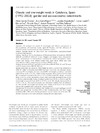Please use this identifier to cite or link to this item:
https://accedacris.ulpgc.es/jspui/handle/10553/44795
| Title: | Obesity and overweight trends in Catalonia, Spain (1992-2003): Gender and socio-economic determinants | Authors: | García-Álvarez, Alicia Serra-Majem, Lluís Ribas-Barba, Lourdes Castell, Conxa Foz, Marius Uauy, Ricardo Plasencia, Antoni Salleras, Lluís |
UNESCO Clasification: | 32 Ciencias médicas 3206 Ciencias de la nutrición |
Keywords: | Waist Circumference Educational-Level Energy Density Prevalence Weight, et al |
Issue Date: | 2007 | Journal: | Public Health Nutrition | Abstract: | Objective: To evaluate the trends of overweight and obesity prevalences in the population of Catalonia, Spain, aged 18-75 years, and the influence of socio-economic determinants on these prevalence trends.Design: Analysis based on data from two representative population-based cross-sectional surveys.Setting: Data from the two Evaluations of Nutritional Status in Catalonia (ENCAT 1992-93 and ENCAT 2002-03), Spain. Weights and heights were obtained by direct measurement in standardised conditions by trained interviewers. Overweight and obesity were defined using body mass index (BMI) and waist circumference (WC), categorised according to WHO criteria.Subjects: In total, 1015 men and 1233 women from ENCAT 1992-93, and 791 men and 924 women from ENCAT 2002-03.Results: Mean BMI and mean WC were higher in males in 2002-03 as compared to 1992-93, while for females mean BMI was lower except for the youngest group, and mean WC was higher. In men, overall BMI overweight prevalence remained stable (from 44.1% to 43.7%), while obesity increased (from 9.9% to 16.6%); total WC overweight remained stable (from 21.7 to 23.8%), while WC obesity increased (from 13.1% to 24.4%). In women, overall BMI overweight increased (from 29.1% to 30.1%), whereas BMI obesity remained stable (from 15.0% to 15.2%); total WC overweight decreased (from 21.8% to 17.7%), while WC obesity increased (from 24.5% to 31.1%). The socio-economic and education variables had an influence BMI and WC overweight and obesity rates mainly on females in both surveys and on the youngest men only in the 1992-93 survey.Conclusions: Ten-year trends indicate that Catalan males are getting bigger overall (BMI) and around the waistline (WC), while Catalan females only have bigger waistlines (WC). BMI male obesity prevalence has overtaken that of females. WC obesity continues to be more prevalent among females than males. | URI: | https://accedacris.ulpgc.es/handle/10553/44795 | ISSN: | 1368-9800 | DOI: | 10.1017/S1368980007000973 | Source: | Public Health Nutrition [ISSN 1368-9800], v. 10, p. 1368-1378 |
| Appears in Collections: | Artículos |
SCOPUSTM
Citations
73
checked on Jun 8, 2025
WEB OF SCIENCETM
Citations
67
checked on Jun 8, 2025
Page view(s)
94
checked on Nov 30, 2024
Download(s)
135
checked on Nov 30, 2024
Google ScholarTM
Check
Altmetric
Share
Export metadata
Items in accedaCRIS are protected by copyright, with all rights reserved, unless otherwise indicated.
